I am interested in applied ecological questions at the intersection of population, community, and ecosystem ecology. I am particularly interested in understanding how societally-relevant questions about wildlife management and population ecology can be informed by data on trophic interactions, spatial ecology, and physiological responses of wildlife to urbanization, habitat fragmentation, and land-use change. My research to date has involved six major integrated themes.
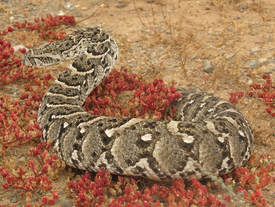
Venomous snakebite & the human-animal-ecosystem interface
Together with the University of Geneva Institute of Global Health, I am helping to develop better tools for doctors to use when making treatment decisions in venomous snakebite cases. Through the Snapp project, our ultimate objective is to improve clinical management of snakebite (e.g. correct antivenom administration) in poor countries with high snakebite burden by supporting clinicians and other healthcare professionals, as well as snakebite victims, in the identification of snakes. We also aim to improve snake education, global mapping of snake geographic distribution, and epidemiological data on venomous snakebite, with potential for new species discovery & furthering goals in conservation & herpetology. I was recently awarded an NSF BRC-BIO award to continue this work.
Together with the University of Geneva Institute of Global Health, I am helping to develop better tools for doctors to use when making treatment decisions in venomous snakebite cases. Through the Snapp project, our ultimate objective is to improve clinical management of snakebite (e.g. correct antivenom administration) in poor countries with high snakebite burden by supporting clinicians and other healthcare professionals, as well as snakebite victims, in the identification of snakes. We also aim to improve snake education, global mapping of snake geographic distribution, and epidemiological data on venomous snakebite, with potential for new species discovery & furthering goals in conservation & herpetology. I was recently awarded an NSF BRC-BIO award to continue this work.
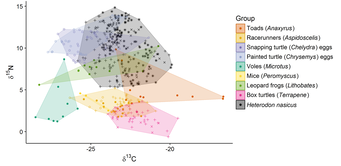 Figure from Durso & Mullin 2017
Figure from Durso & Mullin 2017
Stable isotopes and food webs, from producers to top-level consumers
A major component of my graduate work has been creating quantitative food webs using stable isotopes. This started as an attempt to measure the diet of hard-to-study species and has become a central focus because of the potential to quantify ecosystem services, make comparisons of food web structure across ecosystems, evaluate competition, and distinguish between source & process information in stable isotope ratios. Comparisons with other non-traditional methods for studying diet (e.g. fecal eDNA, fatty acid biomarkers) are a relatively new focus that I hope to grow in the future, filling an urgent need for more experimental comparisons among methods for diet tracing in ecology.
A major component of my graduate work has been creating quantitative food webs using stable isotopes. This started as an attempt to measure the diet of hard-to-study species and has become a central focus because of the potential to quantify ecosystem services, make comparisons of food web structure across ecosystems, evaluate competition, and distinguish between source & process information in stable isotope ratios. Comparisons with other non-traditional methods for studying diet (e.g. fecal eDNA, fatty acid biomarkers) are a relatively new focus that I hope to grow in the future, filling an urgent need for more experimental comparisons among methods for diet tracing in ecology.
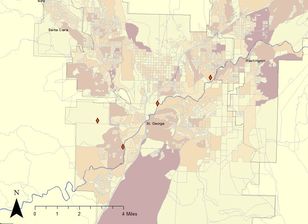
Ecophysiological effects of urbanization on wildlife life-history trade-offs
A major aspect of my dissertation work in Susannah French's lab at Utah State University was examining the effects of urbanization on physiology & population demography. By tracing labeled amino acids through the bodies of gravid female lizards that were healing wounds, I demonstrated that vitellogenesis and wound healing compete for amino acids and for fatty acids and quantified the direction and magnitude of the trade-offs. I combined stable isotopes with hormone and immune assays to understand how to build better food webs for reptiles, understand what they are eating, what eats them, how much they compete with one another, and how that changes when there are changes in the environment such drought or urbanization.
A major aspect of my dissertation work in Susannah French's lab at Utah State University was examining the effects of urbanization on physiology & population demography. By tracing labeled amino acids through the bodies of gravid female lizards that were healing wounds, I demonstrated that vitellogenesis and wound healing compete for amino acids and for fatty acids and quantified the direction and magnitude of the trade-offs. I combined stable isotopes with hormone and immune assays to understand how to build better food webs for reptiles, understand what they are eating, what eats them, how much they compete with one another, and how that changes when there are changes in the environment such drought or urbanization.
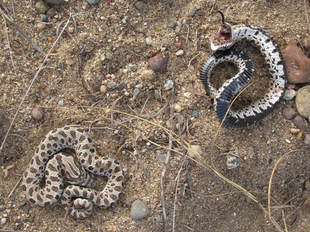
Predator & anti-predator behavior
During my master's work in Steve Mullin's lab at Eastern Illinois University I studied the behavior of western hog-nosed snakes in the wild. Although "death-feigning" as a defensive behavior has been known for centuries, we still don't understand exactly why it works, how it evolves, or which predators it is effective against. Some people suspect that anatomical or physiological adaptations that reduce escape speed may play a role, including diets rich in toxins, an idea that is supported by multiple lines of evidence. I have an abiding interest in these topics and continue to collaborate with others working on them, especially the labs of Al Savitzky and Edmund D. “Doc” Brodie Jr., to reach a better understanding of the evolution and consequences of toxin resistance in snakes & other animals.
During my master's work in Steve Mullin's lab at Eastern Illinois University I studied the behavior of western hog-nosed snakes in the wild. Although "death-feigning" as a defensive behavior has been known for centuries, we still don't understand exactly why it works, how it evolves, or which predators it is effective against. Some people suspect that anatomical or physiological adaptations that reduce escape speed may play a role, including diets rich in toxins, an idea that is supported by multiple lines of evidence. I have an abiding interest in these topics and continue to collaborate with others working on them, especially the labs of Al Savitzky and Edmund D. “Doc” Brodie Jr., to reach a better understanding of the evolution and consequences of toxin resistance in snakes & other animals.
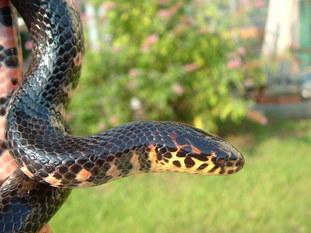
Population and community ecology, with an emphasis on imperfect detection of cryptic species
Since my earliest entry into scientific research, I have been fascinated & frustrated by the problem of imperfect detection. Many species have detection probabilities closer to 0 than 1 — because they are infrequently encountered, they are considered "rare" although some are actually common. Very low detection stymies rigorous population estimation & all but prevents serious community ecology. My efforts to use occupancy modelling to measure detection probability of rare & cryptic snakes began at the Savannah River Ecology Lab where I did an NSF REU summer research project with Whit Gibbons. I continue to collaborate with researchers who I met at SREL, such as J.D. Willson and Rich Seigel, and my lab conducts ongoing monitoring of wetland snake communities in southwest Florida. Future goals include linking rare predator demography and behavior to ecosystem processes such as plant physiology or soil biogeochemistry.
Since my earliest entry into scientific research, I have been fascinated & frustrated by the problem of imperfect detection. Many species have detection probabilities closer to 0 than 1 — because they are infrequently encountered, they are considered "rare" although some are actually common. Very low detection stymies rigorous population estimation & all but prevents serious community ecology. My efforts to use occupancy modelling to measure detection probability of rare & cryptic snakes began at the Savannah River Ecology Lab where I did an NSF REU summer research project with Whit Gibbons. I continue to collaborate with researchers who I met at SREL, such as J.D. Willson and Rich Seigel, and my lab conducts ongoing monitoring of wetland snake communities in southwest Florida. Future goals include linking rare predator demography and behavior to ecosystem processes such as plant physiology or soil biogeochemistry.
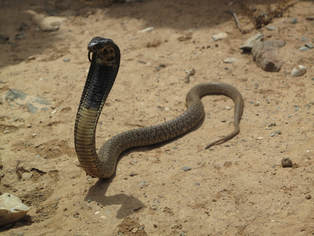
Global biodiversity, distribution, ecology, and modern natural history of snakes
Snakes are one of the most speciose vertebrate clades, exceeding 4,000 described species early in the 2020s. We know incredibly little about many of them. One of my lifelong aims is to gather, structure, and make available data on distribution, anatomy, diet, reproduction, and other relevant aspects of snake biology, taking advantage of large open data sets from biodiversity platforms, citizen science databases, social media, museums, books, unindexed or poorly-indexed journals, gray literature, and expert collections. As a contributor to The Reptile Database and the Global Atlas of Reptile Distributions, I collaborate with others who share the goal of bringing data on reptiles into the 21st century, and as a contributor to several citizen science databases I think about the process of gathering & using these kinds of data all the time. Integrating public outreach and education with data collection can change attitudes towards snakes and help the public stay safe, respect wildlife, and promote conservation.
Snakes are one of the most speciose vertebrate clades, exceeding 4,000 described species early in the 2020s. We know incredibly little about many of them. One of my lifelong aims is to gather, structure, and make available data on distribution, anatomy, diet, reproduction, and other relevant aspects of snake biology, taking advantage of large open data sets from biodiversity platforms, citizen science databases, social media, museums, books, unindexed or poorly-indexed journals, gray literature, and expert collections. As a contributor to The Reptile Database and the Global Atlas of Reptile Distributions, I collaborate with others who share the goal of bringing data on reptiles into the 21st century, and as a contributor to several citizen science databases I think about the process of gathering & using these kinds of data all the time. Integrating public outreach and education with data collection can change attitudes towards snakes and help the public stay safe, respect wildlife, and promote conservation.
